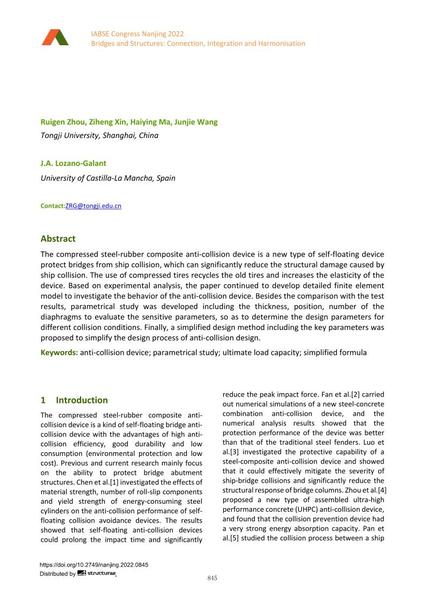Parametric Study and Design Method of Compressed Steel-Rubber Composite Anti-Collision Device

|
|
|||||||||||
Détails bibliographiques
| Auteur(s): |
Ruigen Zhou
(Tongji University, Shanghai, China)
Ziheng Xin (Tongji University, Shanghai, China) Haiying Ma Junjie Wang (Tongji University, Shanghai, China) J. A. Lozano-Galant (University of Castilla-La Mancha, Spain) |
||||
|---|---|---|---|---|---|
| Médium: | papier de conférence | ||||
| Langue(s): | anglais | ||||
| Conférence: | IABSE Congress: Bridges and Structures: Connection, Integration and Harmonisation, Nanjing, People's Republic of China, 21-23 September 2022 | ||||
| Publié dans: | IABSE Congress Nanjing 2022 | ||||
|
|||||
| Page(s): | 845-853 | ||||
| Nombre total de pages (du PDF): | 9 | ||||
| DOI: | 10.2749/nanjing.2022.0845 | ||||
| Abstrait: |
The compressed steel-rubber composite anti-collision device is a new type of self-floating device protect bridges from ship collision, which can significantly reduce the structural damage caused by ship collision. The use of compressed tires recycles the old tires and increases the elasticity of the device. Based on experimental analysis, the paper continued to develop detailed finite element model to investigate the behavior of the anti-collision device. Besides the comparison with the test results, parametrical study was developed including the thickness, position, number of the diaphragms to evaluate the sensitive parameters, so as to determine the design parameters for different collision conditions. Finally, a simplified design method including the key parameters was proposed to simplify the design process of anti-collision design. |
||||
| Copyright: | © 2022 International Association for Bridge and Structural Engineering (IABSE) | ||||
| License: | Cette oeuvre ne peut être utilisée sans la permission de l'auteur ou détenteur des droits. |
||||
